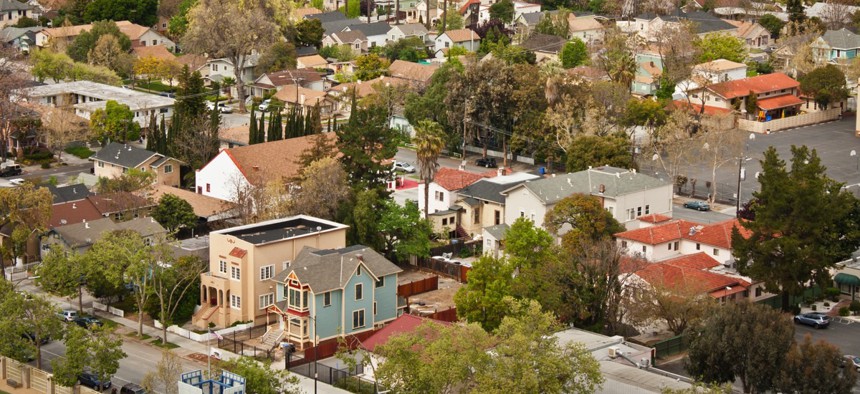Gridlocked Illinois Stops Paying State Salaries; ‘Wealth Adjacent’ Big City Is Just Plain Poor

San Jose, California pbk-pg / Shutterstock.com

Connecting state and local government leaders
Also: Fracking revenue drops in pock-marked Pennsylvania, the nation is grossly underestimating solar-power generation and a resident revolt in small-town South Dakota
SPRINGFIELD, Illinois: Government-shutdown politics is grinding through its stages in the Land of Lincoln, and state employees are caught in its gears. Minority Republican legislators won’t support a state budget drawn up by majority Democrats, who want nothing to do with the pro-business proposals being pushed by Republican Gov. Bruce Rauner. The parties appear to be nowhere close to compromise agreement even though the state budget is overdue. It’s just more of the new normal in divided government politics—except no: A Cook County judge is having none of it and has ruled that state employees will not receive their salaries until the elected officials do their job and pass a budget. Enter political panic and finger-pointing. Illinois Public Radio reports that the lawmakers have three options, all that are less-than-ideal. [Illinois Public Radio / WUIS]
SAN JOSE, California: Why is the third-largest-city in the wealthiest state of the Union and located in the heart of filthy rich Silicon Valley desperately short of public funds—so short it has had to mothball fire trucks? As KQED reports, it’s because the city is what they’re calling “wealth adjacent,” which means its residents leave the city every morning to go to work in places like Palo Alto, Cupertino and Mountain View, where with every lunch and noontime trip to the mall they pay sales tax to those cities and not the overgrown bedroom community with the low property taxes where they live. It’s a city-planning problem that dates to the post-war era, in which developers put down a gazillion houses and left no place for offices or factories or warehouses—the kind of structures where all the house dwellers could go to work. San Jose needs a new tax base. [KQED]
NATIONWIDE: Energy agencies may be under-reporting how much solar photovoltaic power the country is producing by as much as a third. According to a new solar industry report, agency staffers can accurately measure power generated by utility-scale solar plants, but they are just roughly estimating the amount generated on the nation’s rooftops—and they are apparently being way too conservative in their estimates. This is a big deal for state governments, where boards and legislatures are tasked with signing off on utility rate-hikes, green-lighting new power plant construction projects and setting renewable energy standards. They also required this year to formulate long-term plans on how to meet the Environmental Protection Agency’s historic Clean Power Plan targets.
Well, you can see the problem. Those targets look woefully inadequate in light of the new Solar Energy Industries Association and kWh Analytics report. Agency staffers working with the bad data, set the national solar contribution target for 2030 at 8.7 million megawatt-hours. That would appear to be less than a third of what the United States will be generating in solar power by the end of this year.
Warning, residents. A big cloud of bad data has moved over the country and it is blotting out the sun. [Greentech Media via Vox]
PITTSBURGH, Pennsylvania: The green is flowing a little less fast through the spigot into the Commonwealth's coffer, as everyone knew it would someday, reports The Pittsburgh Post-Gazette. Pennsylvania is on track this year to bring in the lowest amount of revenue from shale gas-drilling since it began collecting impact fees in 2012. The global market price for natural gas remains low, so drillers have poked less new wells and they are drawing less gas from wells that are already up and running. Pennsylvania expects to pull in $189.6 million in its “impact fees” this year, or somewhere between $14.9 million and $33.9 million less than in years past. The money is used to compensate for wear and tear on local communities, but roughly 50 percent goes first to a state fund. So local roads in Keystone State gasland will be a little bumpier for now, in more ways than one. [Pittsburgh Post-Gazette]
HARTFORD, South Dakota: Maybe it was a psychological thing. Maybe the residents of this middle-of the-country town near Sioux Falls—there are 2,926 of them—weren’t ready to give up on the chance that just the right job-creating company is out there ready to be reeled in. They rose up this month against a city council decision to terminate the town’s economic development director position. “You sent a clear message that you as a city government no longer want to invest in the economic development of your city,” said Joan Franken, a resident and the owner of Costello Companies in Sioux Falls, according to the Argus Leader, which reported on Tuesday’s city council meeting and the protest to get the decision overturned.
All 50-plus seats in the council chambers were taken by orange-clad Growing Hartford supporters at Tuesday’s meeting, as were the chairs lining both sides of the hallway leading outside, where dozens more were unable to get in.
The reluctant council had no choice. Members agreed to hold a special election Aug. 25 and ask voters officially whether or not to retain a place on the payroll for a new economic development specialist. [Argus Leader]

NEXT STORY: Transportation Trumps 'No Taxes' in Many States




